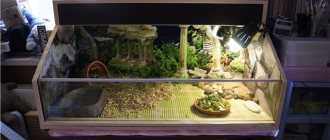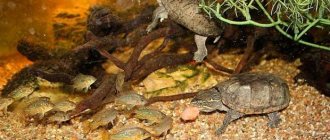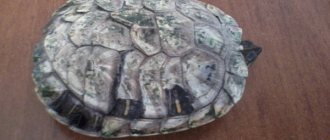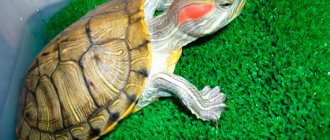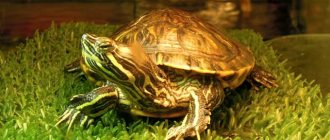Being able to distinguish a boy turtle from a girl turtle will be useful not only for those who want to find a little friend at home, but also for those who are going to start breeding turtles professionally. Most people who love these slow-moving reptiles with a soulful gaze simply do not understand how to find out the gender of their pet, what nickname to give it, and so on. You can find out the gender based on some external signs. The easiest way to do this is when little Tortilla has already become a sexually mature person at one and a half to two years old.
turtle claws
If you carefully examine the paws of a reptile, you can see the difference between male and female individuals. Males have much stronger, thicker and longer claws than females. This is due to the need to fixate their body during the mating period. Females have small and blunt claws.
However, the length of the claws is not a 100% indicator for determining the sex of a land turtle. A reptile's claws can wear down throughout its life. It depends on the conditions in which the turtle lives and what kind of covering is in the aquarium, as well as the duration of its stay on land.
Recommendations to the owner for reproduction
Turtles are animals that reproduce quite poorly in captivity. In order to successfully breed these unusual animals, you need to take some steps. So, what needs to be done to ensure that turtles reproduce at home.
Arrangement of the terrarium
Sufficient space is required for turtles to move freely. Therefore, the first thing you need to pay attention to is the area of the terrarium. Height is of secondary importance, but it should not exceed 45-50 cm.
Since turtles come in different sizes, the size of the terrarium should be appropriate. The recommended size is 5-6 times the size of the animal itself. Several sides of the terrarium and its top should be mesh for air access.
Glass and wood are preferred materials for the terrarium, but durable, non-toxic plastic can also be used.
Stimulation by light and heat
The most important condition for the reproduction of turtles is temperature. It is necessary to ensure an air temperature of +25 +30 °C. This is a must.
A heating lamp is used to ensure the required temperature. It needs to be installed in the corner of the terrarium at a distance of 30-35 cm from the ground surface.
For the health of turtles, in order to prevent rickets, an ultraviolet lamp is used in the terrarium. This light is especially necessary for pregnant turtles and young turtles. Turtles should have at least 10-12 hours of daylight. The UV lamp is turned off at night.
Caring for a female during pregnancy
Actions after turtles mate:
- We place the female and male in different terrariums (this is done so that the male does not harm the female).
- During pregnancy (turtles carry eggs for 2-3 months), you need to feed the female foods that are rich in vitamins, especially calcium.
- Set the temperature in the terrarium to +22 +26 °C.
Incubation period
After laying eggs, the mother's mission ends. The female turtle forgets about her children.
The turtle is isolated for several days. Over the course of 2-3 weeks, the female’s diet is strengthened and saturated with nutrients to restore strength. The eggs are transferred to the incubator.
Arrangement of the incubator:
- Pour a 20 cm thick layer of sand into the incubator.
- Set the temperature to 29 °C and maintain it throughout the incubation period.
- Place a container of water under the heating lamp.
During incubation, turning or moving eggs is prohibited.
After 90 days, offspring will begin to emerge from the eggs.
Newborn care
Young turtles are kept separately from adults. They are kept in the same conditions as adults. The diet should include plenty of plant foods with added calcium.
By studying all the issues on breeding turtles and adhering to certain rules for caring for them, you can successfully get large and healthy offspring.
Sex determination by shell
Another way to determine the sex of a land turtle is by examining its shell - the plastron. If the turtle has a concave plastron, as well as prominent skin growths on the thighs, the so-called femoral spurs, then it is a male. He needs these skin growths to stay on the female during mating.
The female is characterized by a flat shell. In all female individuals, the concavity is almost invisible or completely absent. The male can be identified by its concave abdomen, and the female by its flat or slightly convex abdomen.
Examination of the back of the shell will also help determine the sex of the pet. The male's carapace in the tail area is strongly curved towards the ground. The shell completely covers its tail. Females have a small tail and are completely visible from under the shell.
Females capable of mating are characterized by the presence of visible tubercles on the shell. Males also have similar tubercles at an early age, but as they grow older these tubercles smooth out. Males that have reached sexual maturity have no tubercles and a smooth carapace.
In addition, the shells of male and female turtles differ in shape. In males, the shell has an oblong shape. In females, on the contrary, the shell is wider and rounder.
Reproduction
Now let's find out how turtles reproduce.
Turtles reproduce by mating different sexes and laying eggs, which hatch into offspring.
In what cases does mating occur?
Breeding turtles at home is quite difficult.
To do this, it is necessary to make certain efforts and provide the necessary conditions:
- proper nutrition. It is necessary to include foods rich in vitamin E (vegetable oil, herbs) or vitamin preparations in your diet. Vitamin E has a positive effect on the reproductive system;
- arrange a suitable place for their habitat;
- provide animals with the opportunity to move.
Turtles have sex at any time of the year, provided they are well fed and warm.
Preparation
In order for mating to occur, it is necessary to have several sexually mature individuals of different sexes of the same species, and in no case different ones - this is important. The ratio is two males to one female.
It should be borne in mind that puberty in turtles occurs quite late. Individuals that are too young will not be able to bear offspring. But they shouldn’t be old either. The optimal age is 5 years. It is advisable to have the animals checked by a veterinarian first. Turtles must be healthy and not weakened. Males choose larger females, this must be kept in mind when choosing suitable candidates.
All animals selected for mating should be placed in one terrarium and their behavior observed. When mating games begin and pairs form, the extra turtles need to be moved to another place.
Mating process
How do turtles mate?
The male begins to vigorously jerk his head up and down. Then he extends his limbs, retracts his head and begins to swing and hit the female in the shell. If the female tries to escape, he catches up with her, hits and bites her until she obeys.
If mating does not occur, then it is necessary to seat the turtles and try to bring them together again after a few days.
After pregnancy occurs, the turtle is moved to another terrarium separately from the males.
Behavioral features
Most animals change their character during mating, and red-eared turtles are no exception. By some habits you can understand which sex a particular individual belongs to. First of all, at this time the males perk up, become more active and mobile
How else? After all, the primary task is to attract the attention of a female who is ready to mate. To do this, they stage real performances demonstrating their own capabilities and advantages.
If an individual begins to wave its front legs with long, large claws in front of another turtle, then there should be no doubt that this is a male. In addition, gentlemen at this time become incredibly intrusive and literally do not allow the “brides” passage, while making enticing, playful head movements.
Other signs
In addition to the main signs of determining the sex of turtles, there are others that are less significant.
They are not so obvious and are often specific to a particular species. For the accuracy of the conclusions, it is worth paying attention to them
3.1
Head size and color
Male snapping turtles (silt red-cheeked, mud yellowmouth, musk turtles) have a larger head.
During the mating season, the color of the callagurs' head changes from gray to lighter, almost white, and a bright red stripe appears between the eyes.
3.2
Eye color
Males and females of some turtle species differ in eye color:
- male European marsh turtles can be distinguished by their brown eyes, while females have yellow eyes;
- The male half of Carolina box turtles have red eyes, the female half has brown eyes;
- The iris of male Spengler's mountain turtles is colored blue, while that of females is brown.
3.3
Nose coloring
The gender of representatives of some species can even be determined by the color of their nose. In male Indian yellow-headed tortoises it is red, in females it is yellowish.
3.4
Different behavior
Males are more mobile, especially during the mating season. They chase females, bite their necks, flirt with their claws, nod, and stage unique performances demonstrating their capabilities.
Features of behavior
It is especially possible to determine the sex of red-eared turtles during the mating season. Behavioral characteristics indicate that each pet belongs to one gender or the other. During the mating season, the activity of males increases sharply. They organize all sorts of demonstrations to demonstrate their capabilities. At the same time, they actively swing their front legs, with much larger claws than the females have. During this period, they constantly chase females and make attractive head movements.
If someone is seriously involved in breeding red-eared turtles, then this article will be very useful, since at an early stage, before they are ready to reproduce, turtle pairs can be formed. In addition, such knowledge will help to correctly and accurately name pets, which is very important for many owners.
In pursuit of something unusual, it has recently become fashionable to keep exotic animals such as snakes, boa constrictors, chameleons, etc. at home. This list also includes many species of turtles, including the red-eared slider. All of them are representatives of the tropics and require special attention and special conditions of detention.
It is very important that all those who want to have a red-eared turtle at home understand that it also needs certain conditions, without which it simply cannot live. In addition, this is a very expensive business, since the turtle’s diet must be varied, otherwise it will not be able to develop normally due to lack of nutrients.
